Economics Playlist
18 chapters • 0 completed
Introduction to Economics
10 topics
National Income
17 topics
Inclusive growth
15 topics
Inflation
21 topics
Money
15 topics
Banking
38 topics
Monetary Policy
15 topics
Investment Models
9 topics
Food Processing Industries
9 topics
Taxation
28 topics
Budgeting and Fiscal Policy
24 topics
Financial Market
34 topics
External Sector
37 topics
Industries
21 topics
Land Reforms in India
16 topics
Poverty, Hunger and Inequality
24 topics
Planning in India
16 topics
Unemployment
17 topics
Chapter 1: Introduction to Economics
Chapter TestIntroduction to Economics
Economics is derived from the Greek term ‘Oikonomikos’ meaning household management. It studies how goods and services are produced, distributed, and consumed, and the role of the state in regulating and supporting the economy.
Economics is derived from the Greek term ‘Oikonomikos’ meaning household management. It studies how goods and services are produced, distributed, and consumed, and the role of the state in regulating and supporting the economy.
Major Definitions of Economics
| Economist | Definition | Criticism |
|---|---|---|
| Adam Smith | Science of wealth; focus on national wealth. | Wealth treated as an end. |
| Alfred Marshall | Study of mankind in ordinary business of life. | Ignores immaterial services. |
| Lionel Robbins | Study of human behaviour as relationship between ends and scarce means. | Excludes growth and development. |
Mains Key Points
Prelims Strategy Tips
Basic Concepts in Economics
Economics studies goods, services, and utility. Goods and services satisfy human wants, and utility refers to the want-satisfying power of a commodity. Goods are classified into free, economic, public, private, consumer, and capital goods.
Economics studies goods, services, and utility. Goods and services satisfy human wants, and utility refers to the want-satisfying power of a commodity. Goods are classified into free, economic, public, private, consumer, and capital goods.
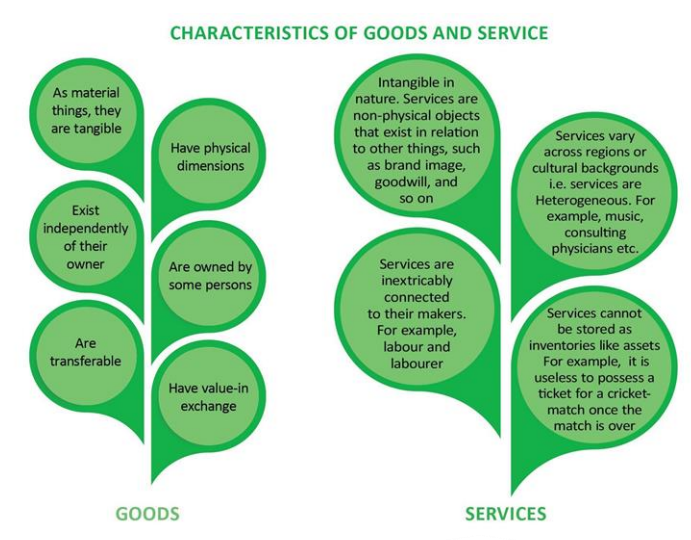
Types of Goods
| Type | Description | Example |
|---|---|---|
| Free Goods | Abundant, no cost to use | Air, Sunshine |
| Economic Goods | Scarce, require payment | Cars, Refrigerators |
| Public Goods | Available for all, irrespective of payment | National defence, Law enforcement |
| Private Goods | Consumed by individuals/households | Food, Drinks |
| Consumer Goods | Used for final consumption | Durable, Non-durable goods |
| Capital Goods | Used in production of consumer goods | Machinery in factories |
Mains Key Points
Prelims Strategy Tips
Concept of Price, Cost, and Indifference Curve
Price is the monetary value of goods. Cost represents the expenditure incurred in production or acquisition. Costs are classified into money cost, real cost, opportunity cost, explicit cost, implicit cost, economic cost, social cost, fixed cost, and variable cost. An indifference curve shows different combinations of two goods giving the same level of satisfaction.
Price is the monetary value of goods. Cost represents the expenditure incurred in production or acquisition. Costs are classified into money cost, real cost, opportunity cost, explicit cost, implicit cost, economic cost, social cost, fixed cost, and variable cost. An indifference curve shows different combinations of two goods giving the same level of satisfaction.
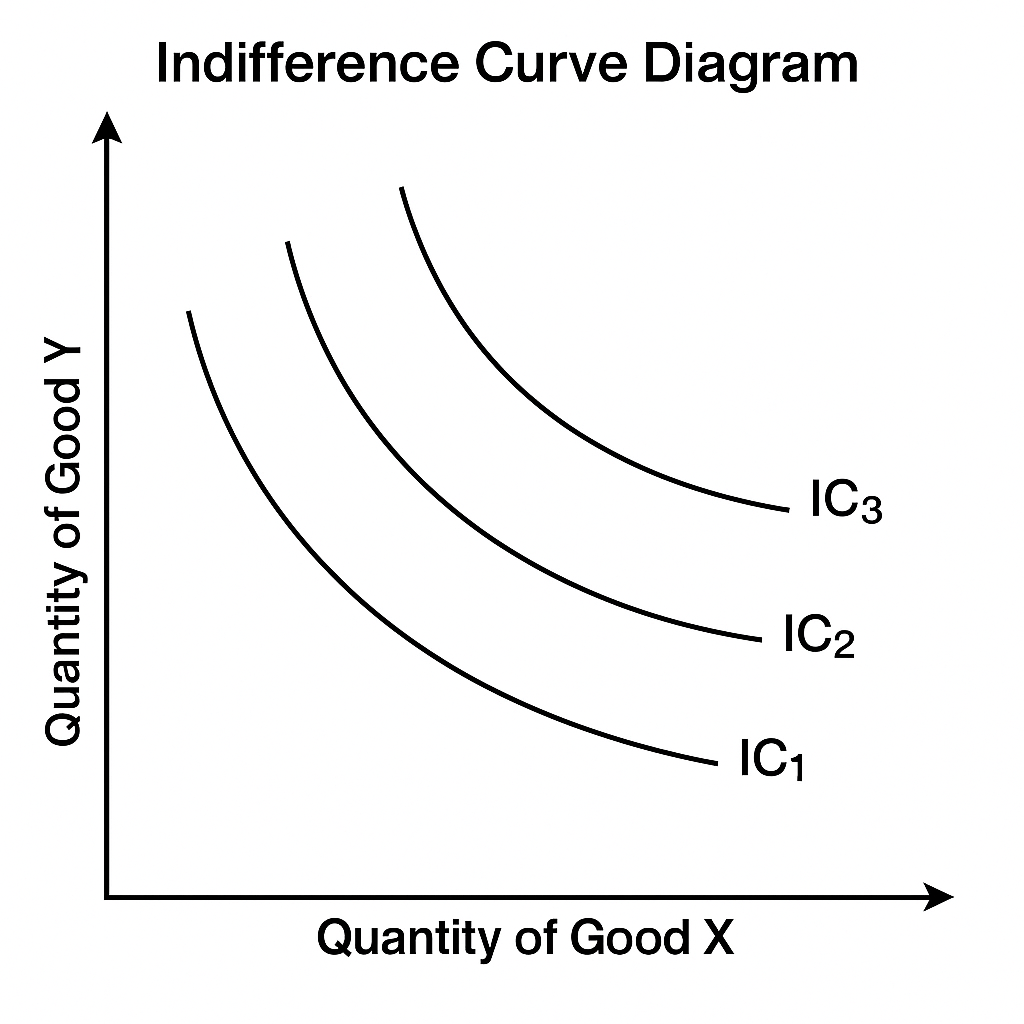
Types of Costs
| Type | Description | Example |
|---|---|---|
| Money Cost | Total money expenditure in production | Raw materials, wages, rent |
| Real Cost | Efforts/sacrifices of factor owners | Labour effort, time |
| Opportunity Cost | Value of next best alternative foregone | Choosing factory land over farming |
| Explicit Cost | Actual payment for inputs | Wages, raw material cost |
| Implicit Cost | Imputed cost of own resources | Using own building for business |
| Economic Cost | Explicit + Implicit costs | Total resource payments |
| Social Cost | Cost borne by society | Pollution from factory |
| Fixed Cost | Constant costs irrespective of output | Rent, taxes |
| Variable Cost | Costs varying with production level | Raw material, fuel |
Mains Key Points
Prelims Strategy Tips
Economic Systems
Economic system refers to the way individuals and institutions are linked to perform economic activities. The three main types are: Capitalist (private ownership and freedom), Socialist (public ownership and central planning), and Mixed (coexistence of private and public sectors).
Economic system refers to the way individuals and institutions are linked to perform economic activities. The three main types are: Capitalist (private ownership and freedom), Socialist (public ownership and central planning), and Mixed (coexistence of private and public sectors).
Comparison of Economic Systems
| Aspect | Capitalist Economy | Socialist Economy | Mixed Economy |
|---|---|---|---|
| Ownership of Property | Private ownership | Public ownership | Both public and private ownership |
| Decision Making | Decentralized, market-driven | Central authority plans | Combination of planning and market |
| Motive | Profit | Social welfare | Profit + Social welfare |
| Competition | Free competition | No competition (state monopoly) | Controlled competition |
| Equality | High inequality | Greater equality | Moderate equality |
Mains Key Points
Prelims Strategy Tips
Sectors in an Economy
An economy is divided into sectors based on the nature of activities: Primary (extraction), Secondary (manufacturing), Tertiary (services), Quaternary (knowledge), and Quinary (decision-making).
An economy is divided into sectors based on the nature of activities: Primary (extraction), Secondary (manufacturing), Tertiary (services), Quaternary (knowledge), and Quinary (decision-making).
Sectors of Economy and Examples
| Sector | Description | Examples |
|---|---|---|
| Primary | Extraction and harvesting of natural resources | Agriculture, fishing, forestry |
| Secondary | Transformation of raw materials into goods | Car manufacturing, construction |
| Tertiary | Service provision (intangible) | Retail, entertainment, finance |
| Quaternary | Knowledge-based activities | Education, R&D, consulting |
| Quinary | Decision-making at top level | Government, corporate executives |
Mains Key Points
Prelims Strategy Tips
Classification of Economics: Microeconomics and Macroeconomics
Economics is classified into Microeconomics (study of individuals and firms) and Macroeconomics (study of the economy as a whole). Micro focuses on demand-supply, pricing, and efficiency at small scale, while Macro addresses national income, employment, inflation, growth, and stability.
Economics is classified into Microeconomics (study of individuals and firms) and Macroeconomics (study of the economy as a whole). Micro focuses on demand-supply, pricing, and efficiency at small scale, while Macro addresses national income, employment, inflation, growth, and stability.
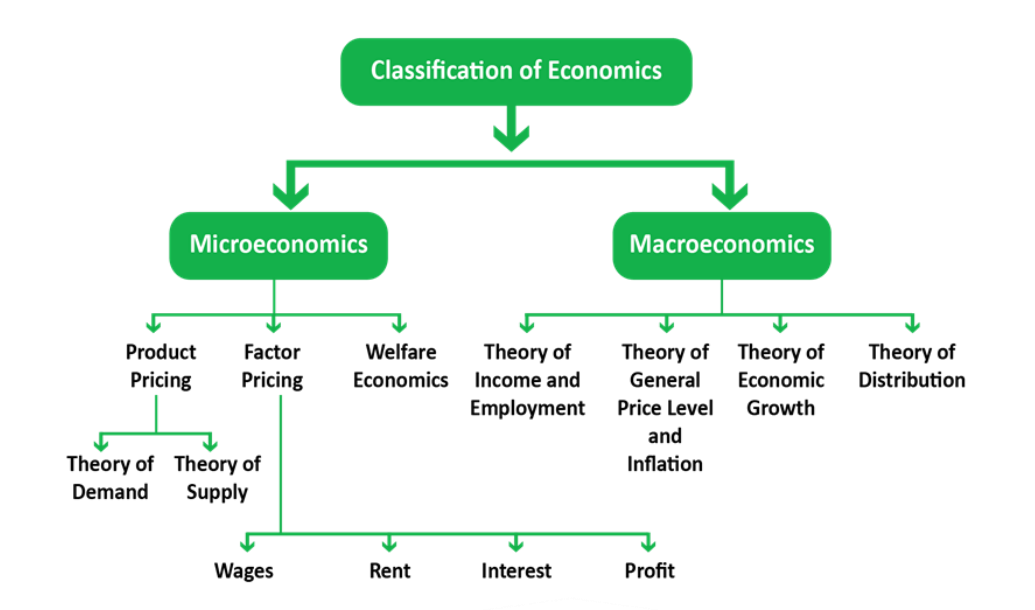
Difference between Microeconomics and Macroeconomics
| Basis | Microeconomics | Macroeconomics |
|---|---|---|
| Domain | Individual units: households, firms, markets | Economy as a whole: aggregates |
| Concerned with | Demand, supply, factor pricing, production, consumption | National income, employment, inflation, growth |
| Approach | Bottom-up (individual decisions form whole) | Top-down (policies impacting entire system) |
| Market Structures | Perfect competition, monopoly, oligopoly | General equilibrium, aggregate demand & supply |
| Applications | Price determination, cost optimization, wage setting | Policy-making, inflation control, unemployment reduction |
| Significance | Known as price theory; micro efficiency | Stability, growth and macro equilibrium |
Mains Key Points
Prelims Strategy Tips
New Branches in Economics and Market
Economics has expanded into new branches like International, Environmental, Developmental, and Health Economics. Market refers to the system of exchange between buyers and sellers, classified on the basis of area and time.
Economics has expanded into new branches like International, Environmental, Developmental, and Health Economics. Market refers to the system of exchange between buyers and sellers, classified on the basis of area and time.
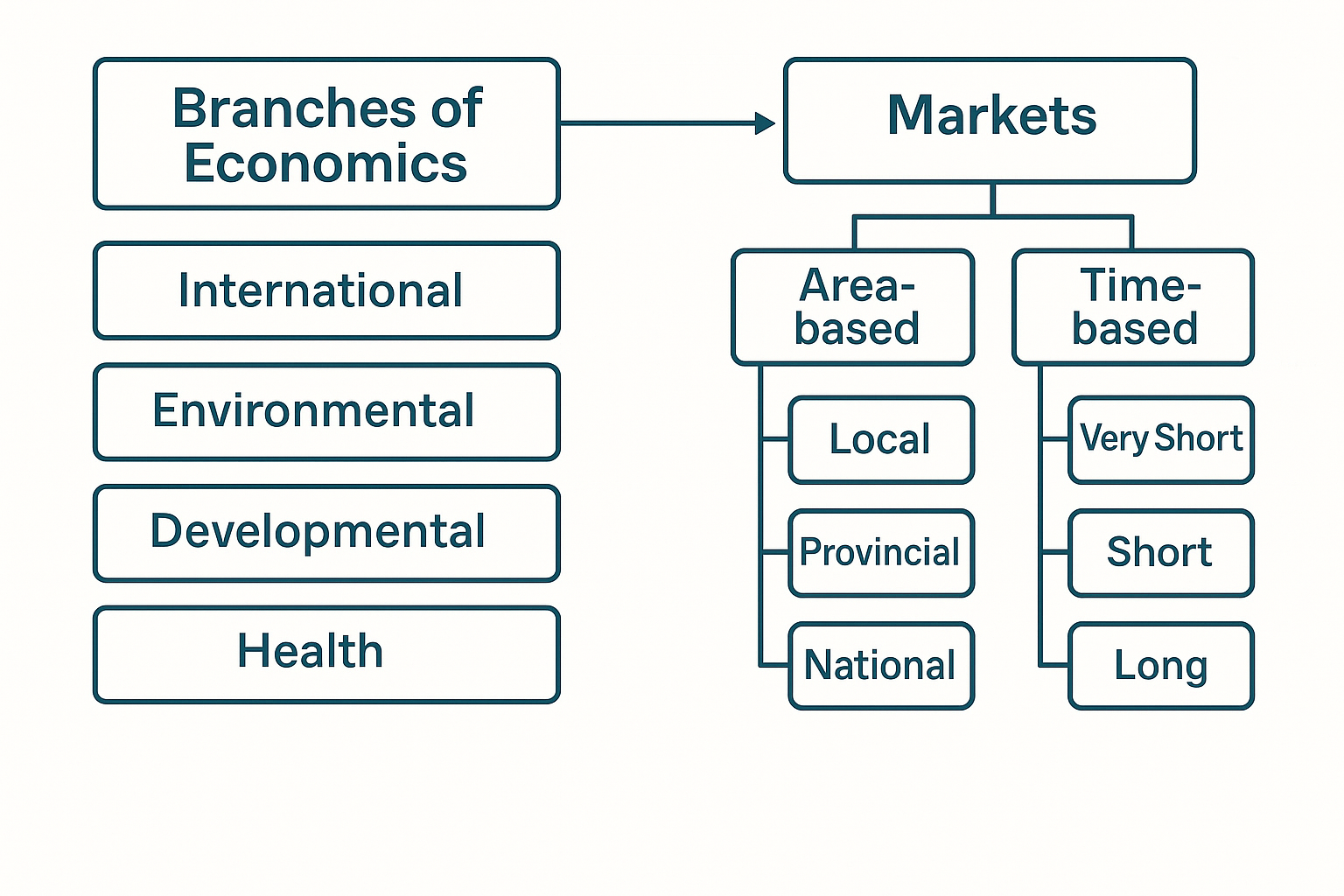
New Branches of Economics
| Branch | Focus | Examples |
|---|---|---|
| International Economics | Trade & interactions among nations | Trade policy, exchange rates, globalization |
| Environmental Economics | Ecology & sustainability | Pollution control, climate change policies |
| Developmental Economics | Improvement in underdeveloped economies | Poverty alleviation, HDI improvement |
| Health Economics | Healthcare systems & efficiency | Drug price control, public health schemes |
Types of Market
| Basis | Type | Description | Examples |
|---|---|---|---|
| Area | Local | Operates in production locality | Vegetables, fruits |
| Area | Provincial | Restricted to a province/region | Regional newspaper |
| Area | National | Operates across entire country | Tea, cement, coffee |
| Area | International | Operates globally | Petrol, gold |
| Time | Very Short Period | Supply cannot change quickly | Perishable goods |
| Time | Short Period | Supply moderately adjustable | Seasonal goods |
| Time | Long Period | Supply fully adjustable with production | Capital goods, durable goods |
Mains Key Points
Prelims Strategy Tips
Classification of Markets: Quantity and Competition
Markets are classified based on the quantity of goods sold (wholesale and retail) and the type of competition (perfect and imperfect). Imperfect competition further includes monopoly, monopolistic competition, oligopoly, and monopsony. Each structure has unique features that determine pricing, efficiency, and consumer welfare.
Markets are classified based on the quantity of goods sold (wholesale and retail) and the type of competition (perfect and imperfect). Imperfect competition further includes monopoly, monopolistic competition, oligopoly, and monopsony. Each structure has unique features that determine pricing, efficiency, and consumer welfare.
Markets on the Basis of Quantity
| Type | Description | Examples |
|---|---|---|
| Wholesale | Bulk selling and buying of goods | Grain market, textile wholesale |
| Retail | Sale in small quantities to consumers | Grocery shops, supermarkets |
Types of Competition in Markets
| Type | Features |
|---|---|
| Perfect Competition | Many buyers/sellers, homogeneous product, uniform price, free entry/exit |
| Monopoly | Single seller, unique product, price maker, barriers to entry |
| Monopolistic Competition | Many sellers, differentiated products, price makers, free entry/exit |
| Oligopoly | Few firms, interdependent pricing, stable prices due to fear of reaction |
| Monopsony | Single buyer, controls price, no substitutes |
Mains Key Points
Prelims Strategy Tips
Supply, Law of Supply and Elasticity of Supply
Supply refers to the quantity of a good that a seller is willing to provide at a given price during a particular period. The Law of Supply shows a direct relationship between price and quantity supplied. Elasticity of Supply measures the responsiveness of supply to price changes.
Supply refers to the quantity of a good that a seller is willing to provide at a given price during a particular period. The Law of Supply shows a direct relationship between price and quantity supplied. Elasticity of Supply measures the responsiveness of supply to price changes.
Types of Elasticity of Supply
| Type | Elasticity Value | Explanation | Example |
|---|---|---|---|
| Relatively Elastic | Es > 1 | Supply changes more than price change | Price ↑ 5%, Supply ↑ 10% |
| Unitary Elastic | Es = 1 | Supply changes equally with price | Price ↑ 10%, Supply ↑ 10% |
| Relatively Inelastic | Es < 1 | Supply changes less than price change | Price ↑ 10%, Supply ↑ 4% |
| Perfectly Inelastic | Es = 0 | Supply does not change at all | Land supply |
| Perfectly Elastic | Es = ∞ | Infinite supply at fixed price | Highly competitive agri market |
Mains Key Points
Prelims Strategy Tips
Market Equilibrium
Market equilibrium is the point where quantity demanded equals quantity supplied. At this point, the price is stable, and both buyers and sellers are satisfied. Any deviation from equilibrium creates surplus or shortage, which adjusts automatically through price changes.
Market equilibrium is the point where quantity demanded equals quantity supplied. At this point, the price is stable, and both buyers and sellers are satisfied. Any deviation from equilibrium creates surplus or shortage, which adjusts automatically through price changes.
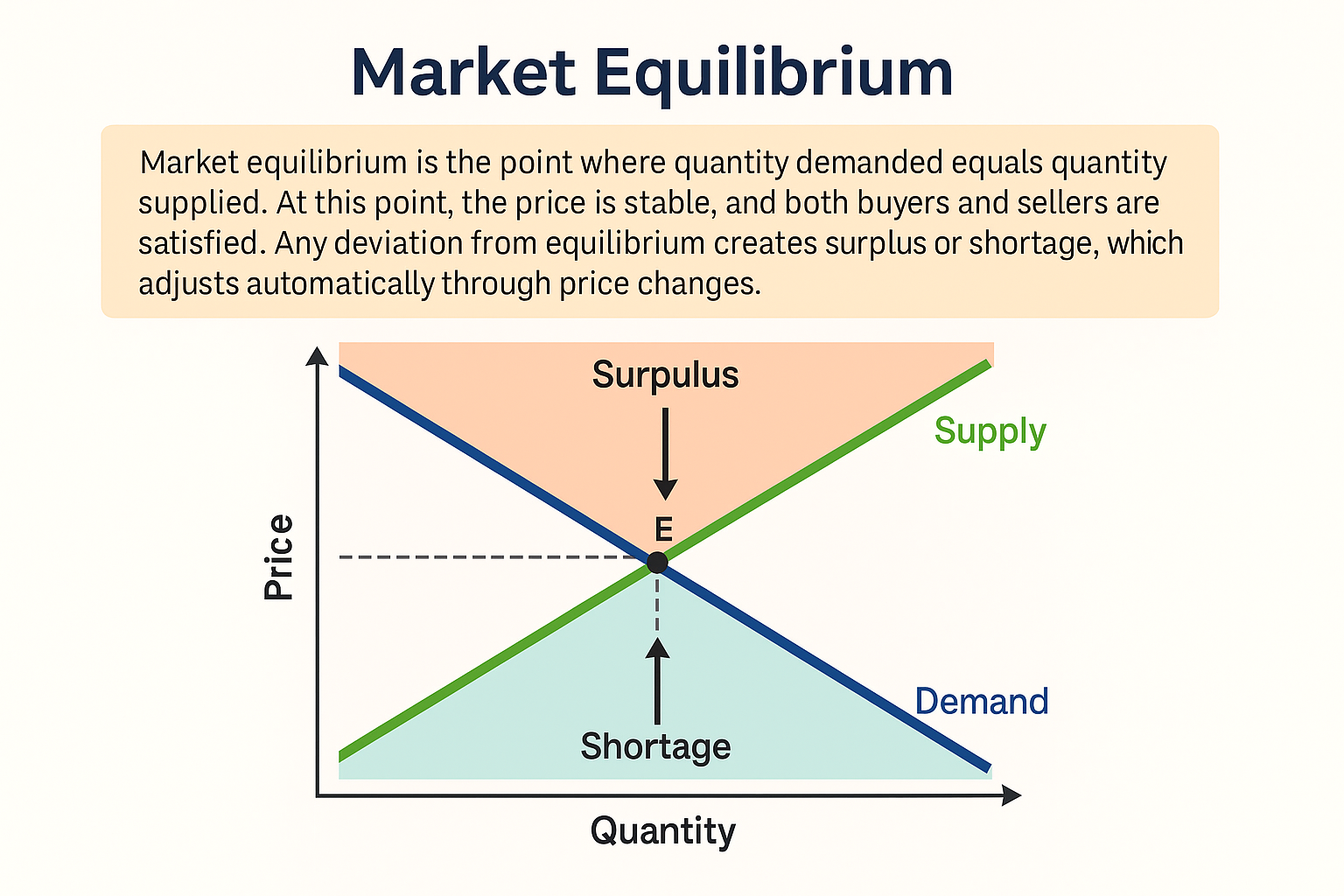
Market Disequilibrium Situations
| Situation | Condition | Effect | Adjustment |
|---|---|---|---|
| Equilibrium | Demand = Supply | Stable price, no shortage/surplus | No adjustment needed |
| Surplus | Supply > Demand (Price > Equilibrium) | Unsold stock accumulates | Price decreases → Demand ↑ Supply ↓ |
| Shortage | Demand > Supply (Price < Equilibrium) | Goods unavailable, competition among buyers | Price increases → Demand ↓ Supply ↑ |
Mains Key Points
Prelims Strategy Tips
Chapter Complete!
Ready to move to the next chapter?
